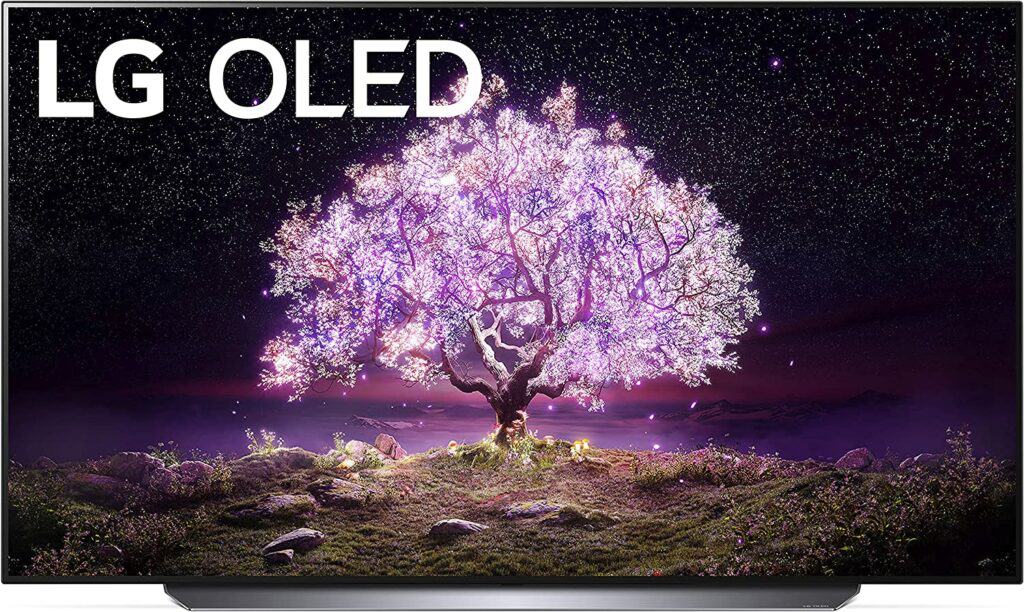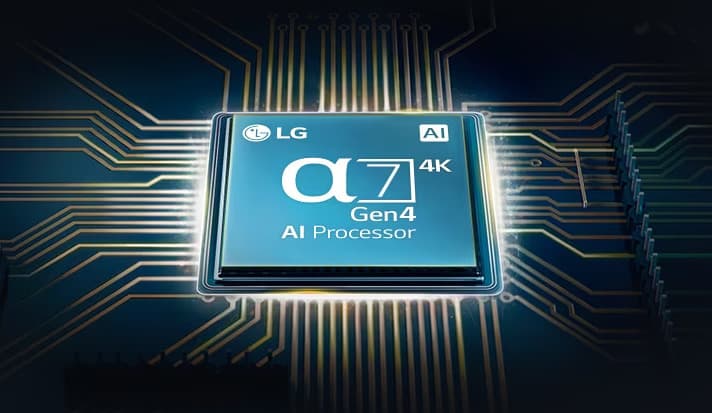Buying a new TV is never an easy decision. Even if you narrow it down to just one manufacturer, there’s still a plethora of choices and differences between models.
Take LG A1 vs C1, for instance. They have the same manufacturer and both are OLEDs, but they have pretty big differences.
What are those differences? Let’s find out.
LG A1 vs C1 – Overview
The A1 model was released in 2021 and is LG’s entry-level OLED, below the B1 and C1. Despite lacking some features of its more expensive brethren like HDMI 2.1, variable refresh rate (VRR), and limited to a 60Hz refresh rate, it’s still capable of delivering very good picture quality.
On the other hand, the C1 was released in the same year (2021) as more of a premium OLED TV, which, of course, makes it a bit more expensive, but you get four HDMI 2.1 ports, VRR and 120Hz refresh rate, plus some other neat features.
| Features | LG A1 | LG C1 |
|---|---|---|
| Screen Sizes (in inches) | 48, 55, 65 and 77 | 48, 55, 65, 77 and 83 |
| Screen Panel | OLED | OLED |
| Processor | a7 Gen4 AI | a9 Gen 4 AI 4K |
| Operating System | webOS 6.0 Smart TV | webOS 6.0 Smart TV |
| Refresh Rate | 60Hz | 120Hz |
| Variable Refresh Rate | No | Yes |
| Resolution | 4K | 4K |
| Contrast Ratio | Infinite: 1 | Infinite: 1 |
| HDMI Ports | 3 (HDMI 2.0) | 4 (HDMI 2.1) |
| USB Ports | 2 (USB 2.0) | 3 (USB 2.0) |
| WiFi and Bluetooth | Yes | Yes |
| Speakers | 20 Watts (2.0) | 40 Watts (2.2) |
| Price | Check Price on Amazon | Check Price on Amazon |
LG A1

Pros:
- Very wide viewing angles
- Near-infinite contrast ratio
- Very fast response times
- Excellent black levels and black uniformity
Cons:
- The interface could be smoother
- Low brightness
- Occasional low frame rate content stutter
LG C1

Pros:
- Very wide viewing angles
- Near-infinite contrast ratio
- Excellent response times
- Great blacks with zero visible blooming
- Great reflection handling
Cons:
- Potential burn-in
- Some colors can be off
Features Face to Face
Panel Technology
Both A1 and C1 models use organic light-emitting diode (OLED) panels, giving them excellent viewing angles and near-instantaneous response times.
In addition, both models are also W-OLEDs (white OLED), which means it uses a white pixel with RGB filters so the color volume and gamut aren’t as good as with QD-OLED (quantum-dot OLED) panels (take a look at our Sony A95K vs Samsung S95B comparison to see some great QD-OLEDs).
Winner: Draw
Image Processor
The LG A1 uses the α7 Gen4 Processor 4K.

This is LG’s mid-tier CPU, and it stands between α5 and α9 processors. It has four cores, a frequency of 1008GHz, 2GB RAM, 8GB ROM built-in memory and its graphics processor contains two cores and 700MHz frequency.
On the other hand, the LG C1 has the newer a9 Gen4 AI 4K Processor under its hood.

This CPU also has four cores and a frequency of 1008Ghz, 3GB RAM and 8GB of built-in ROM, while the graphics CPU has two cores and 700MHz frequency.
Winner: LG C1
Motion Technology
The LG A1 TV has very good response times of 7.3ms. The issue, however, is that it’s limited to 60Hz and lacks variable refresh rate (VRR) and black frame insertion (BFF).
The C1 model, however, has near-instantaneous response times (2.3ms), a 120Hz refresh rate and includes both VRR and BFI, giving it a clear advantage when it comes to motion tech.
Winner: LG C1
Picture Quality
As OLEDs, both A1 and C1 have Inf: 1 native contrast (nearly infinite) as it doesn’t have a traditional backlight. This means it has nearly perfect blacks (capable of reaching black levels of 0 nits.)
Winner: Draw
Local Dimming
Since neither of them uses a backlight, they also don’t feature local dimming. However, since they already have a near-infinite contrast ratio, this really isn’t an issue.
Winner: Draw
Peak Brightness
Neither the A1 nor C1 come with particularly good peak brightness, though it’s slightly better on LG C1 (not as good as C2 as we saw in this LG TV: C1 vs C2 comparison).
When it comes to LG A1, it can get 262 nits peak brightness in SDR content and 416 nits in HDR content, which is pretty low (the optimal values for SDR and HDR are 362 nits and 700 nits, respectively).
The LG C1 is slightly better, with 302 nits SDR and especially 639 nits for HDR content (still below the optimal values for peak brightness).
Winner: LG C1
Color
As for the color gamut and volume, the two models are almost neck-and-neck.
However, the LG A1 has an ever-so-slight edge here as it covers a wider DCI P3 color space with 97.04% DCI P3 xy and 99.08% DCI P3 uv, whereas LG C1 covers 96.33% DCI P3 xy and 98.82% DCI uv.
The C1, however, gets a slight advantage in terms of color volume though both models suffer from lower peak brightness.
Here, the A1 has a 32.9% 10,000 nit Rec 2020 coverage, while LG C1 has a 3.4% coverage. That is, the percentage of colors the TV can display in a 0 to 10,000 nits luminance range within the Rec 2020 color gamut.
Winner: Draw
Viewing Angles
In general, OLEDs have very good viewing angles, and these two models are proof of this.
The LG A1’s viewing angles are truly excellent, with color washout beginning only at 70 degrees, while you might see some color shift (colors can have a blue tint) at 32 degrees.
All of this makes the LG A1 perfect for wide-seating arrangements.
That’s not to say that the LG C1 is a slouch here. However, with the color washout (how fast the color loses its original graph) at 57 degrees and color shift at 30 degrees, it has to concede this one to LG A1.
Winner: LG A1
Reflections / Anti-Glare
Both models handle reflections and glare rather well.
However, the LG A1’s semi-gloss screen finish can’t hold a candle to the full-glossy finish of the LG C1.
In addition, with 1.4% total, 0.2% indirect and 1.2% calculated direct reflections compared to A1’s 2.0% total, 0.4% indirect and 1.6% calculated direct reflections, the LG C1 is a better choice for bright rooms.
Winner: LG C1
Sound Quality
The LG A1 has a 2.0 channel speaker system with 20 Watts output power and a down-firing speaker direction and also has Dolby Atmos.
As such, it can provide okay-ish sound, with a balanced sound profile on low-to-mid levels, but there’s some distortion on high volumes.
The LG C1, in comparison, has a 2.2 channel speaker system with 40 Watts output power and a down-firing speaker direction, with stand front firing. It also has Dolby Atmos.
It’s still not perfect when it comes to frequency, and you’ll get compression at higher volumes, but overall, the sound profile is well-balanced, even if the bass is a bit on the weaker side (though that’s the problem with most TVs).
Winner: LG C1
Smart TV Platform (Operating System)
Both LG A1 and LG C1 use webOS version 6.0 Smart OS.
This is a very user-friendly OS with a smooth interface and plenty of app options.
Winner: Draw
Connectivity
Inputs
| Inputs | LG A1 | LG C1 |
|---|---|---|
| HDMI Ports | 3 (HDMI (2.0) | 4 (HDMI 2.1) |
| USB Ports | 3 | 2 |
| Ethernet | Yes | Yes |
| Digital Audio Output | Yes | Yes |
| 3.5mm Audio Jack | Yes | Yes |
Unfortunately, the LG A1 doesn’t have HDMI 2.1, so it’s limited to 2.0 bandwidth. This means it doesn’t support resolutions such as 1080p@120Hz or 4K@120Hz, but only 60Hz resolutions.
When it comes to the total number of ports, the A1 model has three HDMI and two USB 2.0 ports, as well as a Digital Optical Audio Out and a 3.5 Analog Audio Out, plus Ethernet.
Since it has a 120Hz refresh rate, the LG C1 supports many more resolutions, including, for instance, 1080p@120 or 4k@120Hz.
It also, supports HDMI 2.1, and it has four HDMI ports, three USBs, one Digital Optical Audio Out, a 3.5mm Analog Audio Out, and an Ethernet port.
Voice Assistant
As with all other LG OLED TVs, both A1 and C1 support LG ThinQ AI and have integrated Google Assistant or Amazon Alexa.
Winner: Draw
Wireless Technologies
Both LG A1 and C1 support 2.4GHz and 5GHz WiFi as well as Bluetooth 5.0.
Winner: Draw
Conclusion
Even though the cheaper LG A1 model gave a good showing, even beating the C1 in some categories, overall, we have to give our vote to LG C1 as the better OLED TV in this LG A1 vs C1 comparison.
Looking for more LG C1 comparisons? Check out these articles: